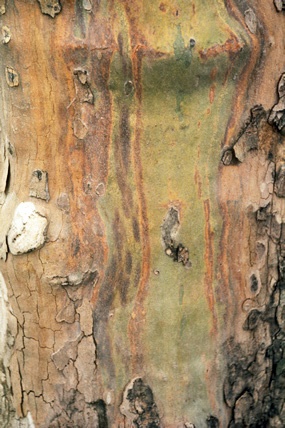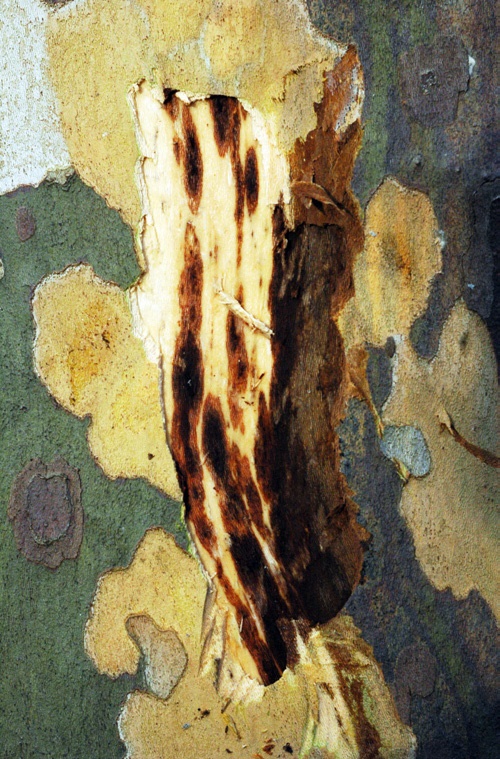Not present in United Kingdom
Notifiable – see ‘Report a sighting’ below
Scientific name of causal agent – Ceratocystis platani

Canker stain of plane is a disease which can affect several species of plane trees (trees in the Platanus genus).
It is caused by the ascomycete fungus Ceratocystis platani (C. platani), which was formerly known as Ceratocystis platani f. platani and Ceratocystis fimbriata s. sp. platani.
The disease has also been known as plane tree wilt.
Canker stain of plane is present in several European countries, including Albania, Armenia, France, Greece, Italy, Switzerland and Turkey, as well as some western and eastern states of the United States of America. There are unconfirmed reports from some other European countries. More-detailed information about its distribution is available from the European & Mediterranean Plant Protection Organization (EPPO) database.
It is not known to be present in the UK. Affected trees decline so markedly that it is unlikely that the disease would have remained undetected if it had reached here. See ‘Official action’ below for details of a survey conducted in 2014.
C. platani can infect most species of plane trees. Among them is London plane (Platanus x acerifolia, also known as Platanus x hispanica), which is widely grown in British towns and cities.
London plane is a naturally occurring hybrid, and its parent species, eastern or Oriental plane (P. orientalis) and western or American plane (P. occidentalis), can also be infected.
This pathogen poses a significant risk to plane trees in the UK because plane is widely used as an urban amenity species in parks and public gardens, and alongside streets and roads. They are valued for their shade, amenity value and toleration of air pollution and water shortages. Their habit of shedding bark allows them to cast off particulate pollutants, while their large, stiff leaves make them excellent shade trees. Once infected, trees die within two to ten years.
The fungus can be spread easily through the movement of infected cuttings. It produces resilient, long-lived spores which spread the disease, and these can persist in soil and on un-sterilised pruning and cutting tools.
The disease’s presence in our near neighbours and trading partners in continental Europe heightens the risk of its being accidentally introduced into the UK.
The concern therefore is that if C. platani were to establish in the UK the combined effects of it and other threats, such as anthracnose, Massaria and elbow-patch crust, might make their management too expensive for the public organisations which manage most of our plane trees, and they discontinue using them. Few other tree species are as well suited to the role currently fulfilled by plane trees.
C. platani infection causes pronounced staining of the xylem (the cells which transport fluid and nutrients up the tree from the roots), severe wilting and yellowing (chlorosis) of the leaves, and tree death.

Staining can extend longitudinally (above and below) in the sapwood at a rate of 50–100 cm per year. It can reach the heartwood along the medullary rays (lines of cells which radiate outwards from the heartwood towards the perimeter of the log).

Infected trees exhibit sparse chlorotic (yellowing) foliage, and sometimes sunken, elongated or lens-shaped cankers (like oozing sores) in the bark (below). These can become roughened and black with age.

Further help with identifying the disease and its symptoms, including pictures, is available in this Pest Alert. (Please note: where contact details in the Pest Alert differ from those given on this page, please use those on this page.)
Some of the ‘Additional resources’ listed below also have illustrations.
Although C. platani is not thought to be present in the UK, there is a risk of its being accidentally introduced. We therefore encourage tree and ground-care professionals, plane tree owners and managers, and the public, to be vigilant for signs of it and to report suspected sightings immediately.
People receiving or handling imported plane material should be especially vigilant.
Please note that TreeAlert and TreeCheck both require photographs to be uploaded. These should be clear, well-lit, close-up pictures of symptoms.
Alternatively, suspected sightings can be made directly to the relevant plant health authority. This is the preferred route for suspected sightings made on trade premises, such as nurseries and garden centres.
In all cases, provide precise details of the location and, if possible, clear, well lit, close-up photographs of the symptoms.
Infection commonly occurs through spores entering fresh wounds on healthy plane trees, such as those made by wind damage, birds, insects, and tree-care tools such as saws and knives. Contaminated tree surgeons’ and forestry workers’ gloves, ropes, clothes and boots might also spread the fungus.
The disease can also be transferred through root contacts between neighbouring trees, and by water. This latter pathway is thought to be the main means by which the famous avenue of plane trees bordering the Canal du Midi in France became infected. (See ‘Origins and background’ below.)
The disease mostly proliferates through human activity. Its spread can therefore be limited by sourcing plant material from regions free of the disease, and by practising strict biosecurity (plant hygiene), such as disinfecting tools with alcohol before moving on to the next tree. Larger agricultural and landscaping equipment such as terracing machinery should be jet-washed with water to remove any contaminated soil before moving to new sites.
C. platani can persist for months or years in affected wood and roots, so removal and burning of all infected material is the safest form of control. No effective chemical treatment is currently available.
Tolerant hybrid plane trees are being developed, and one variety has been released to the market in France.
Further guidance on biosecurity is available from the UK Government website.
On behalf of the Forestry Commission, the London Tree Officers’ Association (LTOA) surveyed 2,979 London plane trees in 2014 for symptoms of C. platani infection.
Inspections were undertaken at 53 sites across 28 London boroughs. More than half of the sites surveyed included potential hosts planted during the previous 10 years, and the sites ranged in size from a minimum of 20 to, in some cases, more than 200 trees. No positive findings of C. platani were detected in any of the trees inspected.
The response to discovery of a case in the UK would be guided by the Forestry Commission’s Contingency Plan.
Until December 2019 the UK had European Union Protected Zone status for plane material to provide extra safeguards against accidental introductions of this disease on imported plane plants or wood. In short, the legislation effectively banned the movement of plane plants into the UK unless they had been grown in an area free of canker stain of plane, and were accompanied by a plant passport certifying this.
However, with the re-categorisation of this organism as a Union Quarantine Pest in December 2019, Protected Zone status was no longer applicable. New requirements were therefore introduced for plane plants being moved anywhere in the EU/UK. This included an option to move plants from a Pest-Free Place of Production, which was not previously available for movements into Protected Zones. (The term pest-free applies to disease-causing organisms as well as insect pests.)
On 21 April 2020, following the spread of the disease into northern France, new national measures came into effect to strengthen these protections further. The new measures include more stringent requirements, and are based on the earlier Protected Zone arrangements. Plane tree planting material, other than seeds, intended for planting must now have been grown throughout their lifetime in a pest-free area, i.e. an area free of C. platani.
The new requirements apply to imports to the UK from Albania, Armenia, Switzerland, Turkey, and the United States and the EU-27.
Visit the UK Government website for an explanation of the regulations applying to the importation of:
The C. platani fungus is thought to have originated in North America. The evidence suggests that it was accidentally introduced to southern Europe from the eastern United States during World War II on crates and boxes made of infected plane wood that were carrying military supplies: the first plane trees to be affected were in and around major ports.
It spread rapidly through Italy and into France and Switzerland. Although its progress through France was initially slower, the fungus has been spreading northwards at a much faster rate in recent years. There have been two isolated outbreaks at Île-de-France and Pays-de-la-Loire in Northern France, where the source of the infection has not been confirmed.
For unknown reasons the disease seems to have become less significant in the United States in recent years, but Greece and south-eastern France have experienced serious losses of shade trees. It is seriously affecting the famous avenue of thousands of plane trees lining the banks of France’s Canal du Midi, and many have had to be felled.